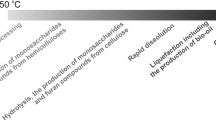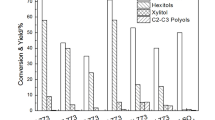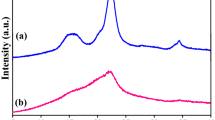Abstract
Solid acid catalysts based on graphite-like mesoporous carbon material Sibunit were developed for the one-pot solubilization–hydrolysis–dehydration of cellulose into glucose and 5-hydroxymethylfurfural (5-HMF). The catalysts were produced by treating Sibunit surface with three different procedures to form acidic and sulfo groups on the catalyst surface. The techniques used were: (1) sulfonation by H2SO4 at 80–250 °C, (2) oxidation by wet air or 32 v/v% solution of HNO3, and (3) oxidation-sulfonation what meant additional sulfonating all the oxidized carbons at 200 °C. All the catalysts were characterized by low-temperature N2 adsorption, titration with NaOH, TEM, XPS. Sulfonation of Sibunit was shown to be accompanied by surface oxidation (formation of acidic groups) and the high amount of acidic groups prevented additional sulfonation of the surface. All the Sibunit treatment methods increased the surface acidity in 3–15 times up to 0.14–0.62 mmol g−1 compared to pure carbon (0.042 mmol g−1). The catalysts were tested in the depolymerization of mechanically activated microcrystalline cellulose at 180 °C in pure water. The main products 5-HMF and glucose were produced with the yields in the range of 8–22 wt% and 12–46 wt%, respectively. The maximal yield were achieved over Sibunit sulfonated at 200 °C. An essential difference in the composition of main products obtained with solid acid Sibunit carbon catalysts (glucose, 5-HMF) and soluble in water H2SO4 catalysts (formic and levulinic acids) as well as strong dependence of the reaction kinetics on the morphology of carbon catalysts argue for heterogenious mechanism of cellulose depolymerization over Sibunit.












Similar content being viewed by others
References
Bhaumik P, Dhepe PL (2016) Solid acid catalyzed synthesis of furans from carbohydrates. Catal Rev 58:36–112
Murzin D, Salmi T (2012) Catalysis for lignocellulosic biomass processing: methodological aspects. Catal Lett 142:676–689
van de Vyver S, Geboers J, Jacobs PA, Sels BF (2011) Recent advances in the catalytic conversion of cellulose. ChemCatChem 3:82–94
van Putten R-J, van der Waal JC, de Jong E, Rasrendra CB, Heeres HJ, de Vries JG (2013) Hydroxymethylfurfural, A versatile platform chemical made from renewable resources. Chem Rev 113:1499–1597
Besson M, Gallezot P, Pinel C (2014) Conversion of biomass into chemicals over metal catalysts. Chem Rev 114:1827–1870
Gallezot P (2012) Conversion of biomass to selected chemical products. Chem Soc Rev 41:1538–1558
Mukherjee A, Dumont M-J, Raghavan V (2015) Review: sustainable production of hydroxymethylfurfural and levulinic acid: challenges and opportunities. Biomass Bioenergy 72:143–183
Wataniyakul P, Boonnoun P, Quitain AT, Sasaki M, Kida T, Laosiripojana N, Shotipruk A (2018) Preparation of hydrothermal carbon as catalyst support for conversion of biomass to 5-hydroxymethylfurfural. Catal Commun 104:41–47
Howard J, Rackemann DW, Bartley JP, Samori C, Doherty WOS (2018) Conversion of sugar cane molasses to 5-hydroxymethylfurfural using molasses and bagasse-derived catalysts. ACS Sustain Chem Eng 6:4531–4538
Delidovich I, Leonhard K, Palkovits R (2014) Cellulose and hemicellulose valorisation: an integrated challenge of catalysis and reaction engineering. Energy Environ Sci 7:2803–2830
Rosatella AA, Simeonov SP, Frade RFM, Afonso CAM (2011) 5-Hydroxymethylfurfural (HMF) as a building block platform: biological properties, synthesis and synthetic applications. Green Chem 13:754–793
Chheda JN, Huber GW, Dumesic JA (2007) Liquid-phase catalytic processing of biomass-derived oxygenated hydrocarbons to fuels and chemicals. Angew Chem Int Ed 46:7164–7183
Alonso DM, Bond JQ, Dumesic JA (2010) Catalytic conversion of biomass to biofuels. Green Chem 12:1493–1513
Cao L, Yu IKM, Chen SS, Tsang DCW, Wang L, Xiong X, Zhang S, Ok YS, Kwon EE, Song H, Poon CS (2018) Production of 5-hydroxymethylfurfural from starch-rich food waste catalyzed by sulfonated biochar. Bioresour Technol 252:76–82
Pagán-Torres YJ, Wang T, Gallo JMR, Shanks BH, Dumesic JA (2012) Production of 5-hydroxymethylfurfural from glucose using a combination of lewis and brønsted acid catalysts in water in a biphasic reactor with an alkylphenol. Solvent ACS Catal 2:930–934
Flèche G (1982) Process for manufacturing 5-hydroxymethylfurfural. USA Patent 4339387
Sasaki M, Fang Z, Fukushima Y, Adschiri T, Arai K (2000) Dissolution and hydrolysis of cellulose in subcritical and supercritical water. Ind Eng Chem Res 39:2883–2890
Zhang YP, Lynd LR (2004) Toward an aggregated understanding of enzymatic hydrolysis of cellulose: noncomplexed cellulase systems. Biotechnol Bioeng 88:797–824
Zhao Y, Lu WJ, Wang HT (2009) Supercritical hydrolysis of cellulose for oligosaccharide production in combined technology. Chem Eng J 150:411–417
Perez S, Mazeau K (2005) Conformation, structures, and morfologies of celluloses. In: Dimitriu S (ed) Polysaccharides. Structural diversity and functional versatility, 2 edn. Marcel Dekker, New York, pp 41–64
Zhang ZC (2013) Chap. 3 - Emerging catalysis for 5-HMF formation from cellulosic carbohydrates. In: Suib SL (ed) New and future developments in catalysis. Elsevier, Amsterdam, pp 53–71. https://doi.org/10.1016/B978-0-444-53878-9.00003-5
Zakrzewska ME, Bogel-Lukasik E, Bogel-Lukasik R (2011) Ionic liquid-mediated formation of 5-hydroxymethylfurfural: a promising biomass-derived building block. Chem Rev 111:397–417
Zheng Y, Zhao J, Xu F, Li Y (2014) Pretreatment of lignocellulosic biomass for enhanced biogas production. Prog Energy Combust Sci 42:35–53
Gromov NV, Taran OP, Sorokina KN, Mischenko TI, Sivakumar U, Parmon VN (2016) New methods for the one-pot processing of polysaccharide components (cellulose and hemicelluloses) of lignocellulose biomass into valuable products. Part 1: methods for biomass activation. Catal Ind 8:176–786
Yu Y, Lou X, Wu H (2008) Some recent advances in hydrolysis of biomass in hot-compressed water and its comparisons with other hydrolysis methods. Energy Fuel 22:46–60
Bobleter O (2005) Hydrothermal degradation and fractionation of saccharides. In: Dimitriu S (ed) Polysaccharides. Structural diversity and functional versatility, 2 edn. Marcel Dekker, New York, pp 893–913
Su J, Qiu M, Shen F, Qi X (2018) Efficient hydrolysis of cellulose to glucose in water by agricultural residue-derived solid acid catalyst. Cellulose 25:17–22
Kim JS, Lee YY, Kim TH (2016) A review on alkaline pretreatment technology for bioconversion of lignocellulosic biomass. Bioresour Technol 199:42–48
Mosier N, Wyman C, Dale B, Elander R, Lee YY, Holtzapple M, Ladisch M (2005) Features of promising technologies for pretreatment of lignocellulosic biomass. Bioresour Technol 96:673–686
Singh R, Shukla A, Tiwari S, Srivastava M (2014) A review on delignification of lignocellulosic biomass for enhancement of ethanol production potential. Renew Sustain Energy Rev 32:713–728
Murzin DY, Murzina EV, Tokarev A, Shcherban ND, Wärnå J, Salmi T (2015) Arabinogalactan hydrolysis and hydrolytic hydrogenation using functionalized carbon materials. Catal Today 2:169–176
Kim K-H, Ihm S-K (2011) Heterogeneous catalytic wet air oxidation of refractory organic pollutants in industrial wastewaters: a review. J Hazard Mater 186:16–34
Levec J, Pintar A (2007) Catalytic wet-air oxidation processes: a review. Catal Today 124:172–184
Nakajima K, Okamura M, Kondo JN, Domen K, Tatsumi T, Hayashi S, Hara M (2008) Amorphous carbon bearing sulfonic acid groups in mesoporous silica as a selective catalyst. Chem Mater 21:186–193
Nakajima K, Hara M (2012) Amorphous carbon with SO3H groups as a solid brensted acid catalyst. ACS Catal 2:1296–1304
Liu X-Y, Huang M, Ma H-L, Zhang Z-Q, Gao J-M, Zhu Y-L, Han X-J, Guo X-Y (2010) Preparation of a carbon-based solid acid catalyst by sulfonating activated carbon in a chemical reduction process. Mol J 15:7188–7196
Bhatnagar A, Hogland W, Marques M, Sillanpaa M (2013) An overview of the modification methods of activated carbon for its water treatment applications. Chem Eng J 219:499–511
Burgess R, Buono C, Davies PR, Davies RJ, Legge T, Lai A, Lewis R, Morgan DJ, Robinson N, Willock DJ (2015) The functionalisation of graphite surfaces with nitric acid: identification of functional groups and their effects on gold deposition. J Catal 323:10–18
Taran OP, Polyanskaya EM, Ogorodnikova OL, Descorme C, Besson M, Parmon VN (2011) Sibunit-based catalytic materials for the deep oxidation of organic ecotoxicants in aqueous solutions. II: wet peroxide oxidation over oxidized carbon catalysts. Catal Ind 3:161–169
Shrotri A, Kobayashi H, Kaiki H, Yabushita M, Fukuoka A (2017) Cellulose hydrolysis using oxidized carbon catalyst in a plug-flow slurry process. Ind Eng Chem Res 56:14471–14478
Taran OP, Descorme C, Polyanskaya EM, Ayusheev AB, Besson M, Parmon VN (2013) Sibunit based catalytic materials for the deep oxidation of organic ecotoxicants in aqueous solutions. III: wet air oxidation of phenol over oxidized carbon and Ru/C catalysts. Catal Ind 5:164–174
Onda A, Ochi T, Yanagisawa K (2008) Selective hydrolysis of cellulose into glucose over solid acid catalysts. Green Chem 10:1033–1037
Onda A, Ochi T, Yanagisawa K (2009) Hydrolysis of cellulose selectively into glucose over sulfonated activated-carbon catalyst under hydrothermal conditions. Top Catal 52:801–807
Pang J, Wang A, Zheng M, Zhang T (2010) Hydrolysis of cellulose into glucose over carbons sulfonated at elevated temperatures. Chem Commun 46:6935–6937
Foo GS, Sievers C (2015) Synergistic effect between defect sites and functional groups on the hydrolysis of cellulose over activated carbon. ChemSusChem 8:534–543
Guo H, Qi X, Li L, Smith RL Jr (2012) Hydrolysis of cellulose over functionalized glucose-derived carbon catalyst in ionic liquid. Bioresour Technol 116:355–359
Dora S, Bhaskar T, Singh R, Naik Viswanatha D, Adhikari DK (2012) Effective catalytic conversion of cellulose into high yields of methyl glucosides over sulfonated carbon based catalyst. Bioresour Technol 120:318–321
Li S, Gu Z, Bjornson BE, Muthukumarappan A (2013) Biochar based solid acid catalyst hydrolyze biomass. J Environ Chem Eng 1:1174–1181
Cao L, Yu IKM, Tsang DCW, Zhang S, Ok YS, Kwon EE, Song H, Poon CS (2018) Phosphoric acid-activated wood biochar for catalytic conversion of starch-rich food waste into glucose and 5-hydroxymethylfurfural. Biores Technol 267:242–248
Liu Z, Fu X, Tang S, Cheng Y, Zhu L, Xing L, Wang J, Xue L (2014) Sulfonated magnetic carbon nanotube arrays as effective solid acid catalysts for the hydrolyses of polysaccharides in crop stalks. Catal Commun 56:1–4
Zhao X, Xu J, Wang A, Zhang T (2015) Porous carbon in catalytic transformation of cellulose. Chin J Catal 36:1419–1427
Guo F, Fang Z, Xu CC, Smith RL Jr (2012) Solid acid mediated hydrolysis of biomass for producing biofuels. Prog Energy Combust Sci 38:672–690
Toda M, Takagaki A, Okamura M, Kondo JN, Hayashi S, Domen K, Hara M (2005) Green chemistry: biodiesel made with sugar catalyst. Nature 438:178–178
Suganuma S, Nakajima K, Kitano M, Yamaguchi D, Kato H, Hayashi S, Hara M (2008) Hydrolysis of cellulose by amorphous carbon bearing SO3H, COOH, and OH groups. J Am Chem Soc 130:12787–12793
Shen S, Wang C, Han Y, Cai B, Li H (2014) Influence of reaction conditions on heterogeneous hydrolysis of cellulose over phenolic residue-derived solid acid. Fuel 134:573–578
Li Y, Shen S, Wang C, Peng X, Yuan S (2018) The effect of difference in chemical composition between cellulose and lignin on carbon based solid acids applied for cellulose hydrolysis. Cellulose 25:1851–1863
Fukuhara K, Nakajima K, Kitano M, Kato H, Hayashi S, Hara M (2011) Structure and catalysis of cellulose-derived amorphous carbon bearing SO3H groups. ChemSusChem 4:778–784
Suganuma S, Nakajima K, Kitano M, Yamaguchi D, Kato H, Hayashi S, Hara M (2010) Synthesis and acid catalysis of cellulose-derived carbon-based solid acid. Solid State Sci 12:1029–1034
Kitano M, Yamaguchi D, Suganuma S, Nakajima K, Kato H, Hayashi S, Hara M (2009) Adsorption-enhanced hydrolysis of ОІ-1,4-glucan on graphene-based amorphous carbon bearing SO3H, COOH, and OH groups. Langmuir 25:5068–5075
Xiong X, Yu IKM, Chen SS, Tsang DCW, Cao L, Song H, Kwon EE, Ok YS, Zhang S, Poon CS (2018) Sulfonated biochar as acid catalyst for sugar hydrolysis and dehydration. Catal Today 314:52–61
Van Pelt AH, Simakova OA, Schimming SM, Ewbank JL, Foo GS, Pidko EA, Hensen EJM, Sievers C (2014) Stability of functionalized activated carbon in hot liquid water. Carbon 77:143–154
Taran OP, Polyanskaya EM, Ogorodnikova OL, Descorme C, Besson M, Parmon VN (2011) Sibunit-based catalytic materials for the deep oxidation of organic ecotoxicants in aqueous solution: I. Surface properties of the oxidized sibunit samples. Catal Ind 2:381–386
Yabushita M, Kobayashi H, Hasegawa JY, Hara K, Fukuoka A (2014) Entropically favored adsorption of cellulosic molecules onto carbon materials through hydrophobic functionalities. ChemSusChem 7:1443–1450
Surovikin VF, Plaxin GV, Likholobov VA, Tiunova LJ (1990) Porous carbonaceous material. USA Patent 4978649
Likholobov VA (2001) Catalysis by unique metal ion structures in solid matrices from science to application. In: Centi G, Wichterlová B, Bell AT (eds) NATO science series. II. Mathematics, physics and chemistry. V. 13. Kluwer Academic Publishers, Netherlands, pp 295–306
Gromov NV, Taran OP, Semeykina VS, Danilova IG, Pestunov AV, Parkhomchuk EV, Parmon VN (2017) Solid acidic NbOx/ZrO2 catalysts for transformation of cellulose to glucose and 5-hydroxymethylfurfural in pure hot water. Catal Lett 147:1485–1495
Pestunov AV, Kuzmin AO, Yatsenko DA, Pravdina MK, Taran OP (2015) The mechanical activation of crystal and wooden sawdust cellulose in various fine-grinding mills. J Siberian Fed Univ Chem 8:386–400
Boehm HP (1966) Chemical identification of surface groups. Adv Catal 16:179–274
Toles CA, Marshall WE, Johns MM (1997) Granular activated carbons from nutshells for the uptake of metals organic compounds. Carbon 35:1407–1414
Park S, Baker J, Himmel M, Parilla P, Johnson D (2010) Cellulose crystallinity index: measurement techniques and their impact on interpreting cellulase performance. Biotechnol Biofuels 3:10
Likholobov VA (2001) Catalysis by novel carbon-based materials. In: Centi G, Wichterlová B, Bell AT (eds) Catalysis by unique metal ion structures in solid matrices from science to application, vol 13. NATO science series. II. Mathematics, Physics. Kluwer Academic Publishers, Netherlands, pp 295–306
Shitova NB, Dobrynkin NM, Noskov AS, Prosvirin IP, Bukhtiyarov VI, Kochubei DI, Tsyrul’nikov PG, Shlyapin DA (2004) Formation of Ru–M/Sibunit catalysts for ammonia synthesis. Kinet Catal 45:414–421
Rodríguez-Castellón E, Jiménez-López A, Eliche-Quesada D (2008) Nickel and cobalt promoted tungsten and molybdenum sulfide mesoporous catalysts for hydrodesulfurization. Fuel 87:1195–1206
Zhuang SX, Yamazaki M, Omata K, Takahashi Y, Yamada M (2001) Catalytic conversion of CO, NO and SO2 on supported sulfide catalysts: II. Catalytic reduction of NO and SO2 by CO. Appl Catal B 31:133–143
Sanders AFH, de Jong AM, de Beer VHJ, van Veen JAR, Niemantsverdriet JW (1999) Formation of cobalt–molybdenum sulfides in hydrotreating catalysts: a surface science approach. Appl Surf Sci 144–145:380–384
Okamoto Y, Imanaka T (1988) Interaction chemistry between molybdena and alumina: infrared studies of surface hydroxyl groups and adsorbed carbon dioxide on aluminas modified with molybdate, sulfate, or fluorine anions. J Phys Chem 92:7102–7112
Hibbert DB, Campbell RH (1988) Flue gas desulphurisation: catalytic removal of sulphur dioxide by carbon monoxide on sulphided La1 – xSrxCoO3. II. Reaction of sulphur dioxide and carbon monoxide in a flow system. Appl Catal 41:289–299
Janaun J, Ellis N (2011) Role of silica template in the preparation of sulfonated mesoporous carbon catalysts. Appl Catal A 394:25–31
Takagaki A, Toda M, Okamura M, Kondo JN, Hayashi S, Domen K, Hara M (2006) Esterification of higher fatty acids by a novel strong solid acid. Catal Today 116:157–161
Moulder JF, Stickle WF, Sobol PE, Bomben KD (1992) Handbook of X-ray photoelectron spectroscopy. Physical Electronics Division, Perkin-Elmer Corporation, Eden Prairie
Zemlyanov DY, Nagy A, Schlögl R (1998) The reaction of silver with NO/O2. Appl Surf Sci 133:171–183
Motoyuki S (1993) Studies in surface science and catalysis. In: Fundamentals of adsorption, vol 80. Elsevier, Amsterdam
Scofield JH (1976) Hartree-Slater subshell photoionization cross-sections at 1254 and 1487 eV. J Electron Spectrosc Relat Phenom 8:129–137
Morrison RT, Boyd RN (1977) Organic chemistry, 2nd edn. Allyn and Bacon Inc., Boston
Gromov NV, Taran OP, Delidovich IV, Pestunov AV, Rodikova YA, Yatsenko DA, Zhizhina EG, Parmon VN (2016) Hydrolytic oxidation of cellulose to formic acid in the presence of Mo-V-P heteropoly acid catalysts. Catal Today 278:74–81
Acknowledgements
This work was supported by the Russian Foundation for Basic Research (Project 17-53-16027) and Russian–French GDRI “Biomass”.
Author information
Authors and Affiliations
Corresponding author
Rights and permissions
About this article
Cite this article
Gromov, N.V., Medvedeva, T.B., Taran, O.P. et al. Hydrothermal Solubilization–Hydrolysis–Dehydration of Cellulose to Glucose and 5-Hydroxymethylfurfural Over Solid Acid Carbon Catalysts. Top Catal 61, 1912–1927 (2018). https://doi.org/10.1007/s11244-018-1049-4
Published:
Issue Date:
DOI: https://doi.org/10.1007/s11244-018-1049-4




